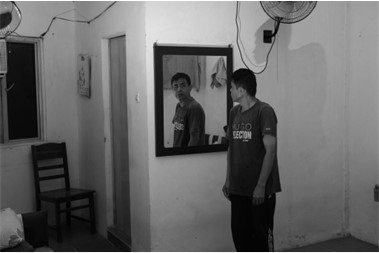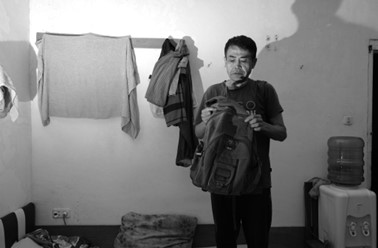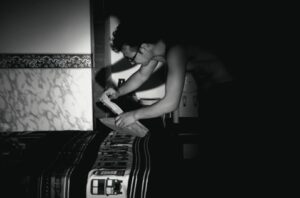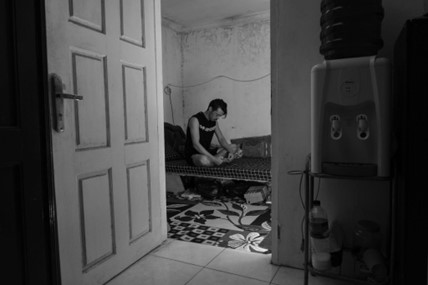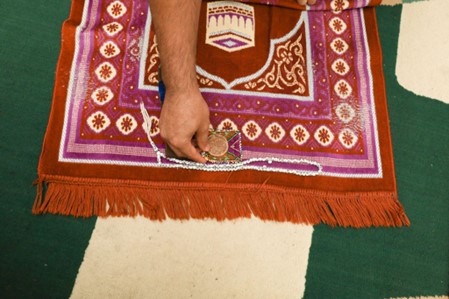
Black and white are the two dominant colours that manifest in the lives of people who are in uncertainty. Sometimes there is a very strong belief, and other times that belief can turn into a feeling of very strong pessimism. Tossed around by the unpredictable dynamics of life and its changes every day, their lives become grey. Like sailing on the high seas without knowing when it will reach land. They have carried only limited items that can keep them alive. Everything has a good reason. especially the last memento. The optimism that comes from it transforms into many colours that make their lives brighter.
Hundreds of refugees have started over again their life in the land of Melayu. Living in a new place where everything feels strange, far away from family and friends creates unbearable homesickness. The last attachments that they carried away have been accompanying refugees leaving their home. Those carried objects can be in any form, such as photos, clothes, keychain, and any other personal item. The objects can be as important as official documents – they become their identity and a door of memory to the place where they come from by giving them a deep meaning, and build cultural, social and emotional bonds toward their families. Hence emotions and memories of their family are always attached wherever they go. In addition more than personal connection, the last memento that refugees bring with them have cultural and historical values.
Situations limit their physical access to the original land. They live in a world full of doubt. Nobody knows when will the circumstances get better so they could meet the loved ones. Even if in the present days technology helps them to keep in touch virtually, it would never be enough. These items may seem trivial, but to the refugees, they are precious reminders of a life that was once theirs. When others can have nostalgic moments by comeback to their past, reminiscing is the only thing that refugees can do, although it may contain pleasant and bitter memories.
This photography essay is about the relation between refugees and their last attachments. Five different items that tell different stories and meaning.
Anwar
Anwar’s backpack is the only possession he had brought with him from Afghanistan. In his solitude this backpack is a symbol of his past life, memories, and experiences he had left behind. He likened his backpack to a tiny house. As he goes to any place this tiny house is always with him. The backpack reminds him of the people he loves, the home he had left, and the life he had known.
Alishah
20 years ago, Alisha’s brother gave him a chain. Since that time, the chain is always with him. When other items that have been purchased are lost or broken, the chain is what is left behind – It is a symbol of him and his brother’s memory. It reminded him of the times, the laughter and the joy they had shared before the war took everything away. The chain gives him hope, reminding him that even in the midst of darkness, there was still something good in the world. Alisha believes the relation between him and his brother is like a chain connected by links.
Ali Murtaza
Ali Murtaza’s rosary was given to him by his mother at the end of time he leaved Afghanistan. The rosary is prayer of his mother – source of ease and strength. It is a form of his mother’s love and care that will protect him, so he shouldn’t be afraid of anything ahead since he holds onto it tightly. The rosary gave him hope, reminding him that even in the middle of a chaotic world where it is fulfilled by destruction, there is still kindness in it.
Abbas
Abbas’s keychain is a sign of love from his sister. Made by colourful tiny beads, it is given to him as a goodbye gift before he left his homeland. The keychain is a reminder that he is not alone. He had family who loved him and were thinking of him even if they are far from each other. The chain gave him hope, reminding him that even in the midst of his difficult journey, there were people who cared.
Hamid
Hamid and his sajadah. Despite various problems and trials refugees faced, many of them doubt the existence of God, but Hamid is consistent with his belief. He still keeps items that connect himself to the transcendent creature–eliminating distances with God. He seeks peace and doesn’t stop hoping in his worship.
The priceless object has been a witness to every phase of their life’s journey. They don’t have to feel lonely because it has a spirit like a human. Every time they see the object, it can decrease the pain from the things they can’t control. So instead of focusing on their grief, they choose to hold onto the last attachment. They keep this possession more than anything else in this world because it is a source of strength and their most cherished treasure for continuing life.
If you liked this piece and would like to help more writers like this publish their work, please consider supporting our writers and artists by becoming a member HERE.
Mohammad Hassan Nazari Ati is a Hazara photographer from Afghanistan. He has been living in Indonesia since 2015. Ati focuses on documentary and street photography. His work has been published by BBC Persian and SBS News Australia. He participated in several exhibitions, such as The Art Exhibition at Sonder Studio (Australia), Eden Art Exhibition (Iran), and Reartsi Fine Art Exhibition at Hang Nadim Gallery (Pekanbaru).


